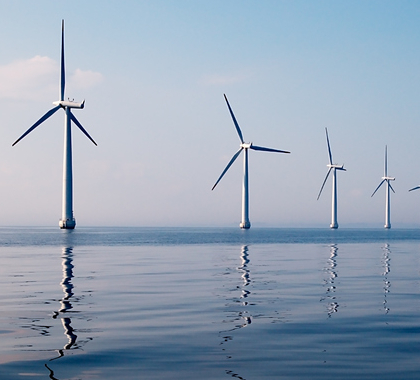Nearly ten years after an offshore wind project failed in Delaware, Gov. John Carney is giving it another shot.
Carney’s August 28 executive order directed the state government to create a “working group” to “help us explore the potential economic and environmental benefits of offshore wind development for Delaware.” The group is supposed to deliver its findings to Carney on December 15.
U.S. Sen. Tom Carper (D-DE), ranking member of the Senate Environment and Public Works Committee and cosponsor of the Incentivizing Offshore Wind Power Act, applauded Carney’s order.
“I’m proud to be part of the effort to grow the offshore wind industry because making smart investments to move us closer to energy independence is a win-win-win for our economy, our security, our health, and our planet,” Carper said in a press statement.
2008 Wind Project Failed
Delaware’s first attempt to develop offshore wind power came in 2008, when Delmarva Power, the state’s only regulated electric utility, became the first utility in the United States to sign a purchase agreement for offshore wind power.
Bluewater Wind planned to build more than 60 wind turbines 11 miles east of Rehoboth Beach, to generate approximately 200 megawatts of power. Despite gaining U.S. Department of the Interior approval of the plan, the Bluewater Wind project collapsed after it was unable to secure federal loan guarantees and other private and public financing.
David Stevenson, director of the Center for Energy Competitiveness at the Caesar Rodney Institute, says the only winner the first time around was Bluewater Wind, which sold its company to NRG energy in 2009 after it signed the contract with Delmarva.
“Bluewater was a start-up company with an exit plan to sell the business as soon as they had a contract, which they did,” Stevenson said. “I actually forecast the demise of the Bluewater Wind project a year before it failed, as the tariff [on ratepayers’ bills] wasn’t large enough to carry the cost.”
Subsequent to the Bluewater project failure, Maryland jumped into the offshore wind game, approving two projects expected to begin operating in 2022. One of the projects is slated for the same offshore tract for which the Bluewater Wind project was planned.
Much More Costly
Economic estimates show offshore wind costs 300 to 400 percent more than other sources of renewable power, such as onshore wind and solar, which are more expensive than electricity from traditional sources such as coal and natural gas. To ensure financing for its offshore wind projects, Maryland imposed a fee of $1.50 per month on all ratepayers’ bills. Delaware Online reports Carney’s working group is expected to consider a similar scheme for Delaware.
Stevenson has estimated the cost of the Maryland offshore wind projects to ratepayers at $6.5 billion over 20 years. Stevenson says neither of the Maryland projects included an estimate of the effect on jobs and wages in the state from higher electricity costs from offshore wind.
“I’ve already shared the analysis of the Maryland Offshore Wind Project with [Gov. Carney] with a note I was trying to save him from a big mistake,” said Stevenson. “He ignored the warning.”
‘Worst Case of Cronyism’
Stevenson says there’s an even bigger lesson for Delaware in the state’s Fuel Cell Tariff passed in 2011. It subsidized a contract between Delmarva Power and Bloom Energy for 30 megawatts of fuel cell generation, which included ratepayer tariffs guaranteeing Bloom Energy and Delmarva Power more than one billion dollars in additional revenue over the next 21 years.
“It has come to represent the worst case of cronyism at ratepayers’ expense in Delaware history, hated by everyone in the state, including the legislature, who looked like fools for passing the Fuel Cell Act,” Stevenson said. “This [offshore wind] project will be a bigger ‘Bloomdoggle’ than the fuel cell project.
“I have told the governor, depending on the size of the [offshore wind] project, this will be several times worse than Bloom,” said Stevenson.
Robert Bradley Jr., CEO and founder of the Institute for Energy Research, says offshore wind power is economically wasteful.
“Onshore wind power is uneconomic; offshore is radically so,” said Bradley. “Environmental and aesthetic concerns have slowed offshore U.S. wind development to date, and there is little reason to think this will not continue to be the case.
“Delaware residents and ratepayers need to keep a wary eye on this project’s developers and their power company,” Bradley said. “What is good for them is not good for the public.”
Expects Unexpected Costs
Jay Lehr, science director at The Heartland Institute, which publishes Environment & Climate News, says there will likely be high unanticipated costs should Delaware move forward with the project.
“One thing I can say for sure is if Delaware is unwise enough to support offshore wind development, the day will come, not too far in the future, when they will regret their decision,” Lehr said. “The net energy produced will be well below what they expected, while capital costs for construction and the maintenance costs of the turbines due to saltwater corrosion will exceed anything they bargained for.
“In addition, those living along and visiting Delaware’s coast will complain about the wind-turbine eyesores blocking their pristine view of the ocean,” said Lehr.
Kathy Hoekstra ([email protected]) writes from Saginaw, Michigan.





